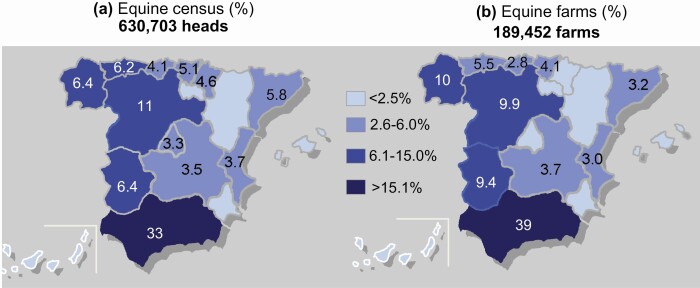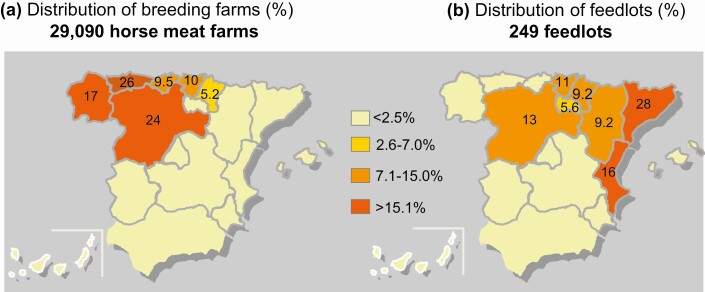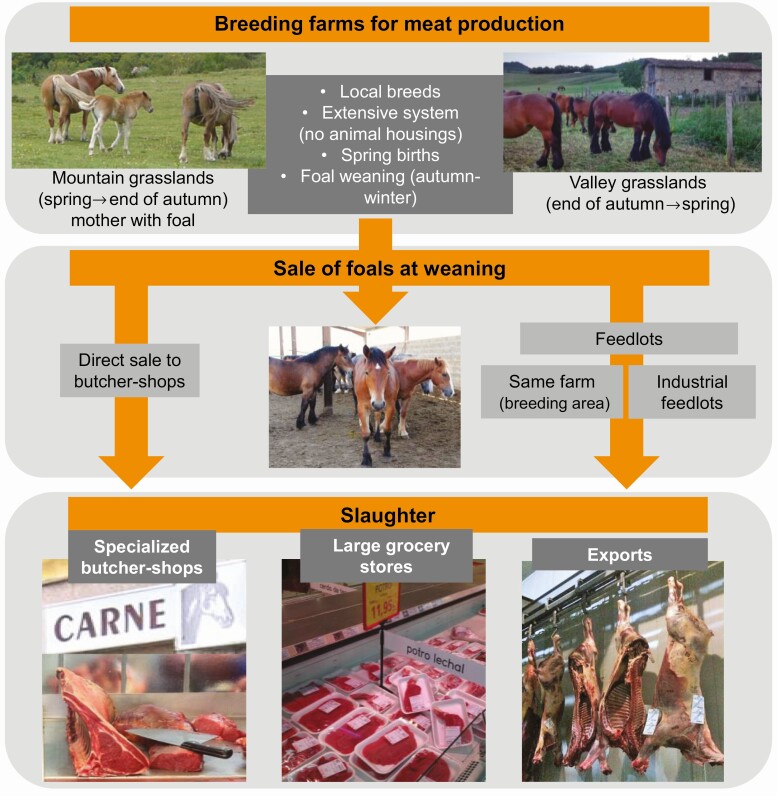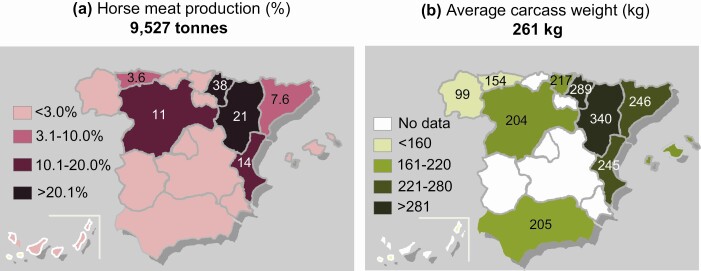Implications.
Pasture-based, extensive livestock systems play an important role in the preservation of the rural landscape, and the many ecosystem services associated.
Spain is the major horse meat producer at EU level, based on traditional extensive systems and a subsequent fattening outside the origin region.
The movement of animals from raising to fattening areas entails a loss of added value in the regions of origin, which decreases farm profitability.
The social recognition of the environmental role of extensive rearing systems based on native breeds and the local production and valorization of the horse meat are crucial objectives that need to be addressed and developed in the following years.
Introduction
The natural environment provides many benefits to humans, which are assessed in terms of ecosystem services. In most mountain regions of Europe, the rural exodus and the abandonment of the traditional practices have led to deep changes in the landscape, decreasing the characteristic mosaicism and the diversity of inherited ecosystems (Martínez-Fernández et al., 2015; Múñoz-Ulecia et al., 2021). As a consequence, many ecosystem services are being affected, such as the biodiversity, the carbon sequestration, and the provisioning value of food for herbivores, among others (Durán et al., 2020; Oggioni et al., 2020). In addition, the current situation of climate change seriously aggravates the problem of land abandonment, especially in areas of high plant productivity. Forest expansion and shrub encroachment are leading to a loss of open spaces, a homogenization of the landscape and an accumulation of fuels that, in a situation of high temperatures and drought, entail high environmental risks.
Europe, as other regions of the world, has undergone in the last decades profound changes in their fire regime, and extreme wildfires are becoming increasingly frequent due to fuel accumulations and to drier and hotter climatic conditions than decades before (Krawchuk et al., 2009; Leys and Carcaillet, 2016). As a consequence, extreme wildfires are one of the most important threats Europeans face nowadays, due to its destructive capacity and its affliction on both human lives and the natural environment (San-Miguel-Ayanz et al., 2013). Until recently, fire policies have mostly focused and invested on fire suppression and have assigned a minor role to fire prevention and to fuel management techniques. However, the high costs of preventing fuel buildups through periodic mechanical clearings of biomass cannot be accomplished with the limited budgets of the public administrations, and a social engagement and an active landscape management are necessary (Sande et al., 2010; Otero and Nielsen, 2017). It is in this context that the role of domestic herbivores and their associated extensive livestock systems become crucial. The capacity of herbivores to ingest high amounts of biomass may constitute an effective tool for reducing vegetation fuels in critical areas of the landscape (Canals, 2019).
Equine farms play an important socioeconomical role in the sustainable development of mountain areas in many regions of southern Europe, and they play a key role as preservers of landscapes. Of the range of domestic herbivores suitable for environmental grazing, horses have several important advantages. Despite being monogastric, they can digest cellulose efficiently, the main organic component of plants, and their big frame size and rapid digestion process ensure a high intake capacity. Their digestive tract is designed to take in small and frequent meals of forage, and they exert a selective pressure on grasslands that results in a characteristic “lawn and rough” pattern according to their dietary preferences (Williams et al., 2020). Horses are estimated to spend about 75% of the daytime and 50% of the nighttime grazing (or a total of 60% of a 24-hr day, Fleurance et al., 2001). In addition, thanks to their size and heavy complexion, they can also gain a control on lignified vegetation through the trampling (personal observation).
Regarding the environment, equines adapt very satisfactorily to extreme climates (cold temperatures, high rainfall, snowfall events) and to rough landscapes, particularly when native breeds are used (Canals, 2019). In the current situation of climate change and the priority to reduce greenhouse gas emissions, horses also have an important advantage over ruminants due to their particular digestive physiology that reduces the production of methane. The emission factor for methane (kg CH4 per head) coming from enteric fermentation is significantly much lower in equines than in ruminants (14 kg CH4 per head of equine vs 48 kg CH4 per head of cattle; FAO, 2020). Similarly, the energy losses in horses due to CH4 production average 3.5% of the feed digestible energy compared to 10% to 13% in adult ruminants (Vermorel, 1997).
Horse Meat Production in Spain
Worldwide, horse meat production (741,003 tonnes and 4,803,585 carcasses) is currently far below the rest of meat-producing species (0.25% of the total, even below goat and rabbit meats), whereas pork (36%), poultry (34%), and bovine (21%) are the most produced and consumed meats.
Spain stands out as the major horse meat producer in the EU (17%), followed closely by Italy (16%), Romania (14%), Poland (11%), and France (8.2%; FAO, 2020). According to the national statistics, the current horse censuses account for 630,703 heads (MAPA, 2020a), distributed in 189,452 farms (Figure 1b), which are mostly concentrated in southern and western Spanish regions such as Andalusia (34%), Extremadura (6.4%), Castile and Leon (12%), Galicia (6.4%), and Asturias (6.2%) (Figure 1a).
Figure 1.
Spanish animal census (a) and equine farms (b) distribution. Source: MAPA (2020a).
Among the national registered horses, most animals are raised for leisure activities and only 6.1% are focused on meat production. The latter corresponds to 38,200 animals slaughtered in 2019, which means 0.4% of the total Spanish livestock production and a value worth of 78M€ (MAPA, 2020a). From the total registered equine farms, 15.3% horses are bred for meat production, and most of them (88%) are located in the north-western regions of Spain (Asturias, Castile and Leon, Galicia, Basque Country, and Cantabria; Figure 2a). In the last decade, horse meat production has increased in the country by 51%, and over 73% of the meat produced goes to European markets. National economical balance for international trade is positive for equine meat (MAPA, 2020b), with higher exports (27M€ and 7,074 tonnes) than imports (0.51M€ and 302 tonnes). The level of local consumption is low (average supply per capita below 0.10 kg, Belaunzaran et al., 2015), but it is increasing in the last years. All these data indicate the potential of this product for both exportation and local consumption.
Figure 2.
Distribution of horse meat farms: (a) breeding farms and (b) feedlots. Source: MAPA (2020a).
The traditional meat production system is based on the raising of native breeds, which were used as draft animals in the past and that were reoriented for meat production after farm mechanization. For decades, equine breeding innovation depended on the weight, which established genetic improvement programs, artificial insemination, etc. When these activities were transferred to the regional governments, the development and promotion of the horse breeds displayed a high variability among regions. As a consequence, a great breed variability can be found nowadays, which is mainly linked to geographical areas: heavy horse breeds (mare live weight > 650 kg) such as Hispano-Bretón (Castille and Leon; Cantabria; and Huesca), Burguete (Navarre), Basque Mountain Horse (Basque Country), and Catalan Pyrenean Horse (Catalonia); medium-frame breeds (351–650 kg) such as Jaca Navarra (Navarre) and crossbred animals; and small-frame breeds (<350 kg) such as Galician Mountain Horse (Galicia), Asturcón (Asturias), Losino (Castile and Leon), Monchino (Cantabria), and Pottoka (Basque Country) (MAPAMA, 2015).
Due to the high rusticity and adaptation of the local breeds, the breeding systems mostly rely on the extensive grazing of the natural resources provided by mountain areas and on the feeding with preserved forages in the most extreme winter months (Figure 3). Animals are capable to adapt to harsh conditions making an effective use of mountain and valley grasslands, shrublands, and open forests (of communal use in some cases). Only occasionally, under adverse climatological conditions, animals are supplemented or remain stabled during short periods. In most of the production areas, animals freely graze in high-altitude pastures from spring until autumn. Then, foals are weaned, and animals move to valley pastures before the first snowfalls of the year, closer to villages but without housing. This is the common production system in small family farm units in which horse farming provides an additional income to the regular cattle farming or even as an alternative when the livestock activity (or main activity) has been left. In some regions such as Galicia, equine production is performed under total free grazing conditions. This traditional system in which herds are kept wild in communal pastures constitutes a tourist attraction of the region when, once a year, horses are collected (“Rapa das Bestas”).
Figure 3.
Scheme of the Spanish horse meat production system.
Until the second half of the 20th century, horse meat available in the markets came from old animals that were not properly finished. Nowadays, a high-quality horse meat derived from fattened foals is produced. After weaning, foals are usually moved to other regions for fattening and slaughter. In Spain, 249 farms are classified as feedlots, focused on foals fattening and representing 0.13% of the total equine farms in the country. Those are primarily located in the east of Spain (Figure 2b). Catalonia (28%) and Valencia (16%), together with Castile and Leon (13%), Basque Country (11%), Navarre (9.2%), Aragon (9.2%), and La Rioja (5.6%) regions, concentrate 92% of the Spanish horse feedlots (MAPA, 2020c).
In the primary production areas, fattening facilities are normally small-size family farms or farms directly owned by local butchers. In these units, 20–25 native animals are reared, and after weaning and a short adaptation period, foals are fed on concentrates and forage until slaughter. Commonly, animals are slaughtered at the age of 12 mo, but depending on marbling and butchers’ requests, meat from 6-mo-old foals is also commercialized. On the other hand, bigger industrial feedlots with capacity for 100–800 animals can be found, which are exclusively dedicated to fattening and meat trading. In these feedlots, a high breed variability is usually found, depending on the region from which suckling foals are purchased (Tragsega, 2003). Foals are generally fattened until 12–15 mo or up to 24 mo of age, and they are intended for bigger consumption areas and/or international exports.
As a result of the current animal management and movements, 81% of the horse meat produced in Spain (9,527 tonnes) is concentrated in four regions: Navarre, 38%; Aragón, 21%; Valencia, 14%; and Catalonia, 7.6% (Figure 4a; MAPA, 2020b), despite these regions accounting for only 8.2% of the breeding farms. The average carcass weight is 261 kg, but significantly heavier carcasses are produced in the fattening regions compared to the extensive production regions (Figure 4b). In the latter, local breeds are usually small sized, and foals are slaughtered at younger ages with carcass weights averaging 150 kg.
Figure 4.
Distribution of the horse meat production (a) and average carcass weights (b) in Spain. Source: MAPA (2020b).
The movement of foals from the north-western to the fattening and slaughtering areas in the north-eastern regions involves a loss of added value in their regions of origin. The finishing of foals in their original regions, besides an opportunity gain for the rural economy, will also ensure an optimal and complete use of the natural resources, and the traceability and highest quality for the final product, the meat. As a consequence, any action that helps and gives support to the local production and valorization of the final product would be beneficial for the producers and for the rural economy.
Nutritional Composition of Horse Meat
Horse meat, as any other meat, is a nutritionally valuable foodstuff. It constitutes a significant source of high-value proteins, iron, zinc, B type vitamins, and selenium with a greater bioavailability compared with that found in other foods (Lorenzo et al., 2014). However, in contrast to other more consumed meat species (i.e., bovine, poultry, or pig), few scientific studies have focused on horse meat quality although it has been recognized as a healthy meat (Lorenzo, 2013; Belaunzaran et al., 2015). Horse meat has a low-fat content and a significant proportion of n-3 polyunsaturated fatty acids (PUFA), such as linolenic (18:3n-3) and other long-chain n-3 fatty acids (FA), that have been reported to have beneficial properties for preventing chronic diseases (Weylandt, 2016). In horses, considering their digestive track, dietary FA are absorbed before the anaerobic microbial hydrogenation occurring in the hindgut (cecum and colon). Thus, the postgastric localization of digestive chambers allows them for an efficient absorption and deposition of n-3 PUFAs coming primarily from pastures. In addition, even though the horse is a nonruminant herbivore, due to a light microbial fermentation taking place in the hindgut, the formation and accumulation of several trans-18:1 and conjugated linoleic acid isomers have been reported (Clauss et al., 2009). The low trans-FA level in horse tissues is not surprising since the formation of nonindustrial trans-FA normally occurs in ruminant species through biohydrogenation processes in the rumen (see review by Aldai et al., 2013).
The aforementioned considerable n-3 PUFA transfer efficiency from pasture to muscle tissue in horses was described in the 1950s (Gupta and Hilditch, 1951), and more recently, several studies have brought up new peculiarities of these animals. Even though horses do not have a gall bladder, the continuous secretion of biliary salts, together with lipase-rich pancreatic juices, provides them the ability to efficiently digest high amounts of dietary lipids in the small intestine. In this regard, a specific pancreatic lipase (pancreatic lipase related to protein 2) that is absent in pigs, turkeys, or ruminants has been described in horses, and has been linked to its capacity to hydrolyze the linolenic acid (18:3n-3) esterified in galactolipids of plants (see recent review by Sahaka et al., 2020). In this line, several studies have pointed out that horse tissues constituted a valuable source of energy and PUFA in the diet of humans in the Paleolithic and the Neolithic, when plants and marine foods were scarce due to recurrent glaciations (Guil-Guerrero et al., 2013), and this could be directly related to the preferential deposition of 18:3n-3 in neutral compared to polar lipids (i.e., subcutaneous fat; Belaunzaran et al., 2017).
Valorization of Horse Meat Production Systems
The concept of High Nature Value (HVN) farming in Europe constitutes a recognition of the fact that the conservation of biodiversity depends on the continuation of low-intensity farming systems and the environmental services and positive externalities they provide. But, for its maintenance, these systems need to be profitable to farmers and rural development is necessary (González-Díaz et al., 2019). Existing support mechanisms such as the agri-environment measures have helped to slow down the loss of these systems, but they are insufficient to make HNV farms commercially viable and ensure its survival in the rural economic structure (Rodríguez-Ortega et al., 2018).
The recognition and valuation of the ecosystem services provided by extensive farming systems is necessary to raise social awareness and design effective communication strategies that contribute to improve the market value of the animal-derived products (Faccioni et al., 2019). That is why new efforts are being carried out to valorize and promote the extensive production system itself, as well as the final product (horse meat), based on its important role in the sustainable development of mountain areas at economic, environmental, and social levels (i.e., the European project Open2preserve, https://open2preserve.eu/en/). Anyway, giving a monetary value to these externalities is a challenge, and many attempts of measurable criteria for the valuation of the ecosystem services provided by pasture-based farming systems are being developed in the last years to that purpose (Bernués et al., 2014; Rodríguez-Ortega et al., 2014; Maldonado et al., 2019; Durán et al., 2020).
In the same line, the Payments for Environmental Services can be a suitable arrangement to remunerate producers for the positive externalities associated to the environmental grazing and to compensate farmers for the complexity of the management and/or the potential decrease in productivity (Sattler et al., 2013; Varela et al., 2018). In the south of Spain, there is a long-lived and successful example of the implementation of payments to shepherds for practicing an extensive and targeted grazing for the maintenance of firebreaks areas. The Red de Áreas Pasto-Cortafuegos de Andalucía (RAPCA) program rewards extensive breeders for their biomass control services in fuel breaks located in public forests. The payments received depend on the size, location, and difficulty of grazing of the area assigned to each shepherd, as well as the degree of accomplishment of the task. The political will, the stable commitment from the public administrations, and the well-designed system of biomass monitoring have been crucial for the success of the program (Varela et al., 2018).
Conclusions
In a scenario of climate change, the preservation of resilient landscapes that encompass as many ecosystem services as possible is necessary, and low-intensity farming systems are to play a key role in them. Pasture-based, extensive equine breeding produces a traceable and remarkable high-quality meat, while offering many positive externalities such as the preservation of mosaic landscapes and its associated biodiversity, the reduction of fuels for wildfire prevention, the recovery of endangered breeds, the maintenance of a primary activity that fixes population, and the low-water and -carbon footprint linked to pasture-based livestock productions with a low-methane emission. From now on, an important work to promote the local production of horse meat and the investment in effective diffusion and communication tools that raise social awareness and contribute to improve the consumption and the market value of these animal-derived products is necessary.
Acknowledgments
The authors thank the financial support provided by Interreg Sudoe OPEN2PRESERVE (SOE2/P5/E0804), UPV/EHU ZALDITRANS (EHUA 13/29) projects, and Basque Government (IT944-16). Also, we appreciate the support provided by Jone Lizarza from INTIA.
About the Authors

Kizkitza Insausti is an assistant professor in Animal Science at the School of Agricultural Engineering and Biosciences at the Public University of Navarra (Spain). She earned a BS, MS, and PhD in Agricultural Engineering from the Public University of Navarra (Spain). She teaches animal science courses, and her research interests include topics related to animal production and its relationship with carcass grading and meat quality. In addition, she works in the sensory analysis of meat and meat products and in the application of new sensing technologies to predict meat quality.

Lorea R. Beldarrain is a PhD student at the Department of Pharmacy and Food Sciences, University of the Basque Country (UPV/EHU) in Vitoria-Gasteiz (Spain). She graduated in Chemistry (2014) and obtained master’s degree in Environmental Contamination and Toxicology (2015). She initiated her research in the field of meat science, under the Food Quality and Safety PhD Programme. Her work addresses the study of horse meat and changes in quality parameters during the aging process. Her main research interests are novel approaches based on chromatography and mass spectrometry techniques applied to muscle tissue.

Mª Paz Lavín is a senior scientist at CSIC (Spanish National Research Council, Mountain Livestock Institute—University of León, León, Spain). She graduated (1989) and earned a PhD (1996) in Veterinary Medicine (University of León, Spain). She is working in the field of animal production, analyzing factors affecting ruminant production systems such as land use, quality of products, traceability, profitability of farms, and animal welfare. The overall aim is to improve the sustainability (economic, social, and environmental) of ruminant production systems.
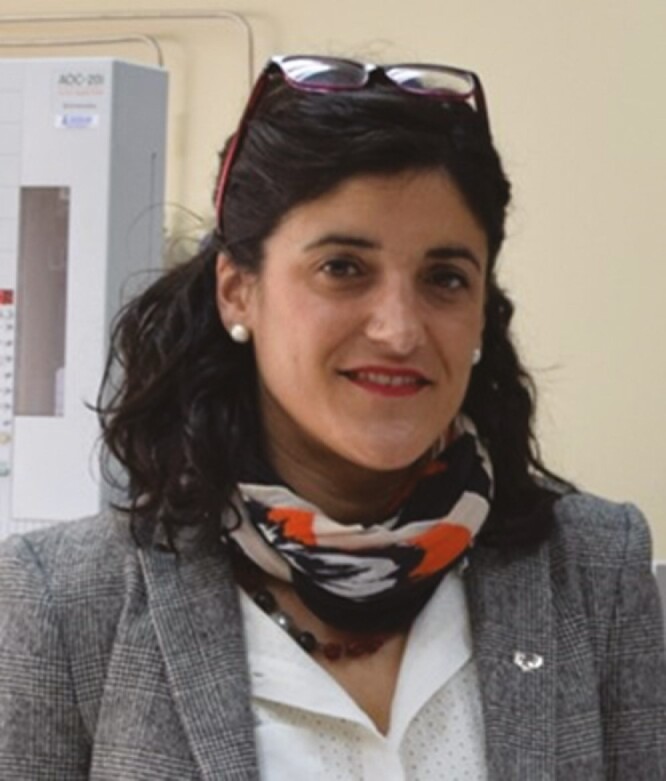
Noelia Aldai is a permanent senior researcher at the Department of Pharmacy and Food Sciences, University of the Basque Country (UPV/EHU) in Vitoria-Gasteiz (Spain). She is an agricultural engineer (1998), and graduated (2000), and earned a PhD (2006) in food Sciences. She is also a postdoc in Agriculture and Agri-Food Canada, Canada; Animal Research Institute, Australia; Faculty of Veterinary Medicine, Portugal; and Spanish National Research Council, Spain (2006–2011). Her main research interests are ruminant fats, evaluating relevant factors influencing their composition, developing strategies to manipulate and improve the nutritional quality of animal products, and assessing analytical methods that demonstrate the value of these products.
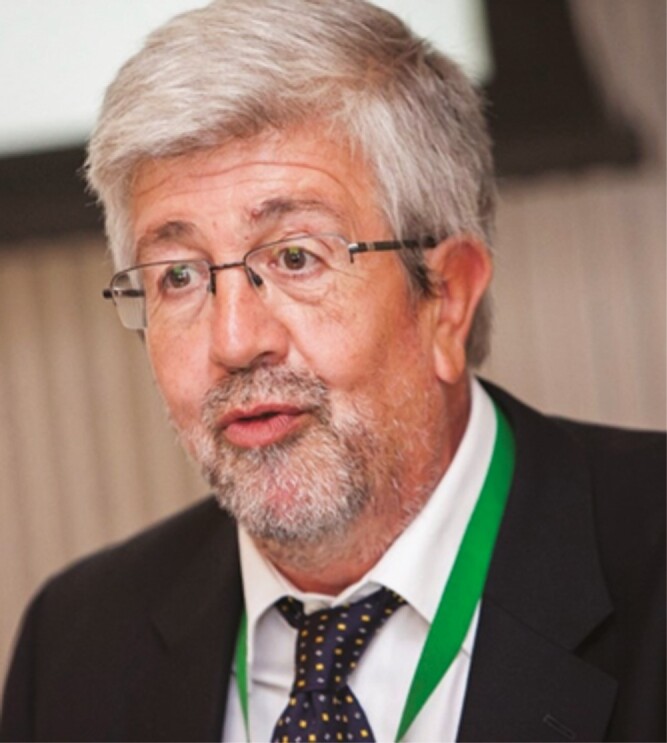
Angel R. Mantecón is a research professor at CSIC (Spanish National Research Council, Mountain Livestock Institute—University of León, León, Spain). He graduated (1981) and earned a PhD (1986) in Veterinary Medicine (University of León, Spain). He has extensive experience as a senior lecturer of Animal Nutrition (Faculty of Veterinary, León; 1981–1990). He is a researcher at MLURI (Edinburgh, UK, 1988–1990). His research activities are focused on nutrition and ruminant production systems, with the overall aim of improving the sustainability (economic, social, and environmental) of animal production systems.

José L. Sáez graduated in MS Agronomy at Universitat de Lleida (Spain), and he earned a BS in agricultural engineering from the Public University of Navarra (Spain). He works in extension as a senior researcher at INTIA, Tecnologías e Infraestructuras Agroalimentarias (Pamplona, Spain), where he is a principal researcher of the projects Life Regen Farming, Open 2 Preserve, and Nefertiti. His research topics focus on organic farming livestock systems in dairy, beef, ewe, lamb, and horse. He is a teacher at the Agroecology University Expert at the Public University of Navarra.

Rosa Ma Canals graduated in Forestry and Agronomy at Universitat de Lleida and PhD in Agronomy at Universidad Pública de Navarra, Spain. Two-year postdoc at the Environmental Science, Policy, & Management Dpt. Division Ecosystem Sciences at the University of California in Berkeley, EUA. Professor at the Universidad Pública de Navarra and member of the Ecology and Environment group in the Research Institute IsFood. Her research topics focus on grass–herbivore relationship, fire ecology, and grassland biodiversity. She has led several multidisciplinary teams to draw up Grassland Management Plans in protected Natura 2000 areas and currently leads the European project Open2preserve (SOE2/P5/E0804), which addresses the restoration of abandoned areas in scenarios of climate change and high wildfire risk.
References
- Aldai, N., de Renobales M., Barron L. J. R., and Kramer J. K. G.. 2013. What are the trans fatty acids issues in foods after discontinuation of industrially produced trans fats? Ruminant products, vegetable oils, and synthetic supplements. Eur. J. Lipid Sci. Technol. 115:1378–1401. doi: 10.1002/ejlt.201300072 [DOI] [Google Scholar]
- Belaunzaran, X., Bessa R. J., Lavín P., Mantecón A. R., Kramer J. K., and Aldai N.. 2015. Horse-meat for human consumption – current research and future opportunities. Meat Sci. 108:74–81. doi: 10.1016/j.meatsci.2015.05.006 [DOI] [PubMed] [Google Scholar]
- Belaunzaran, X., Lavín P., Barron L. J., Mantecón A. R., Kramer J. K., and Aldai N.. 2017. An assessment of the fatty acid composition of horse-meat available at the retail level in northern Spain. Meat Sci. 124:39–47. doi: 10.1016/j.meatsci.2016.10.014 [DOI] [PubMed] [Google Scholar]
- Bernués, A., Rodríguez-Ortega T., Ripoll-Bosch R., and Alfnes F.. 2014. Socio-cultural and economic valuation of ecosystem services provided by Mediterranean mountain agroecosystems. PLoS One 9:e102479. doi: 10.1371/journal.pone.0102479 [DOI] [PMC free article] [PubMed] [Google Scholar]
- Canals, R. M. 2019. Landscape in motion: revisiting the role of key disturbances in the preservation of mountain ecosystems. Geogr. Res. Lett. 45:515–531. [Google Scholar]
- Clauss, M., Grum C., and Hatt J.. 2009. Polyunsaturated fatty acid content in adipose tissue in foregut and hindgut fermenting mammalian herbivores: a literature survey. Mamm. Biol. 74:153–158. [Google Scholar]
- Durán, M., Canals R. M., Sáez J. L., Ferrer V., and Lera-López F.. 2020. Disruption of traditional land use regimes causes an economic loss of provisioning services in high-mountain grasslands. Ecosyst. Serv. 46:101200. [Google Scholar]
- Faccioni, G., Sturaro E., Ramanzin M., and Bernués A.. 2019. Socio-economic valuation of abandonment and intensification of alpine agroecosystems and associated ecosystem services. Land Use Policy 81:453–462. [Google Scholar]
- FAO. 2020. Food and Agriculture Organization of the United Nations. FAOSTAT (year 2018). (19/12/2020). http://www.fao.org/faostat/en/#data
- Fleurance, G., Duncan P., and Mallevaud B.. 2001. Daily intake and the selection of feeding sites by horses in heterogeneous wet grasslands. Anim. Res. 50:149–56. [Google Scholar]
- González-Díaz, J. A., Celaya R., Fernández-García F., Osoro K., and García R. R.. 2019. Dynamics of rural landscape in marginal areas or northern Spain: past, present and future. Land Degrad. Dev. 30:141–150. [Google Scholar]
- Guil-Guerrero, J. L., Rincón-Cervera M. A., Venegas-Venegas C. E., Ramos-Bueno R. P., and Suarez-Medina M. D.. 2013. Highly bioavailable α-linolenic acid from the subcutaneous fat of the Palaeolithic Relict “Galician horse.” Int. Food Res. J. 20:3249–3258. [Google Scholar]
- Gupta, S. S., and Hilditch T. P.. 1951. The component acids and glycerides of a horse mesenteric fat. Bioch. J. 48:137–146. [DOI] [PMC free article] [PubMed] [Google Scholar]
- Krawchuk, M. A., Moritz M. A., Parisien M. A., Van Dorn J., and Hayhoe K.. 2009. Global pyrogeography: the current and future distribution of wildfire. PLoS One 4:e5102. doi: 10.1371/journal.pone.0005102 [DOI] [PMC free article] [PubMed] [Google Scholar]
- Leys, B., and Carcaillet C.. 2016. Subalpine fires: the roles of vegetation, climate and, ultimately, land uses. Clim. Change 135:683–697. [Google Scholar]
- Lorenzo, J. M. 2013. Horsemeat as a source of valuable fatty acids. Eur. J. Lipid Sci. Technol. 115:473–474. [Google Scholar]
- Lorenzo, J. M., Sarriés M. V., Tateo A., Polidori P., Franco D., and Lanza M.. 2014. Carcass characteristics, meat quality and nutritional value of horsemeat: a review. Meat Sci. 96:1478–1488. doi: 10.1016/j.meatsci.2013.12.006 [DOI] [PubMed] [Google Scholar]
- Maldonado, A., Ramos-López D., and Aguilera P.. 2019. The role of cultural landscapes in the delivery of provisioning ecosystem services in protected areas. Sustainability 11:2471. [Google Scholar]
- MAPA. 2020a. El sector equino en cifras: principales indicadores económicos. Subdirección General de Producciones Ganaderas y Cinegéticas, Dirección General de Producciones y Mercados Agrarios. Ministerio de Agricultura, Pesca y Alimentación, Madrid, Spain. [Google Scholar]
- MAPA. 2020b. Informe anual de comercio exterior agroalimentario: 2019. Ministerio de Agricultura, Pesca y Alimentación, Madrid, Spain. [Google Scholar]
- MAPA. 2020c. Encuesta de sacrificio de ganado. Resultados definitivos por provincias y comunidades autónomas (censo exhaustivo). Ministerio de Agricultura, Pesca y Alimentación, Madrid, Spain. [Google Scholar]
- MAPAMA. 2015. Équidos. Bases Zootécnicas para el cálculo del balance alimentario de Nitrógeno y Fósforo. Ministerio de Agricultura y Pesca, Alimentación y Medio Ambiente, Madrid, Spain. [Google Scholar]
- Martínez-Fernández, J., Ruiz-Benito P., and Zavala M. A.. 2015. Recent land cover changes in Spain across biogeographical regions and protection levels: implications for conservation policies. Land Use Policy 44: 62–75. [Google Scholar]
- Múñoz-Ulecia, E., Bernues A., Casasus I., Olaizola A. M., Lobón S., and Martín-Collado D.. 2021. Drivers of change in mountain agriculture: a thirty-year analysis of trajectories of evolution of cattle farming systems in the Spanish Pyrenees. Agric. Syst. 189:102983. [Google Scholar]
- Oggioni, D., Ochoa-Hueso R., and Pecoa B.. 2020. Livestock grazing abandonment reduces soil microbial activity and carbon storage in a Mediterranean Dehesa. Appl. Soil Ecol. 153:103588. [Google Scholar]
- Otero, I., and Nielsen J. O.. 2017. Coexisting with wildfire? Achievements and challenges for a radical social-ecological transformation in Catalonia (Spain). Geoforum 85:234–246. [Google Scholar]
- Rodríguez-Ortega, T., Olaizola A. M., and Bernués A.. 2018. A novel management-based system of payments for ecosystem services for targeted agri-environment policy. Ecosyst. Serv. 34:74–84. [Google Scholar]
- Rodríguez-Ortega, T., Oteros-Rozas E., Ripoll-Bosch R., Tichit M., Martín-López B., and Bernués A.. 2014. Applying the ecosystem services framework to pasture-based livestock farming systems in Europe. Animal 8:1361–1372. doi: 10.1017/S1751731114000421 [DOI] [PubMed] [Google Scholar]
- Sahaka, M., Amara S., Wattanakul J., Gedi M. A., Aldai N., Parsiegla G., Lecomte J., Christeller J. T., Gray D., Gontero B.et al. , 2020. The digestion of galactolipids and its ubiquitous function in nature for the uptake of the essential α-linolenic acid. Food Funct. 11:6710–6744. doi: 10.1039/d0fo01040e [DOI] [PubMed] [Google Scholar]
- Sande, J., Rego F., Fernandes P., and Rigolot E. (editors). 2010. Towards integrated fire management – outcomes of the European project fire paradox. European Forest Institute Research Report 23. Porvoo, Finland: WS Bookwell Oy. [Google Scholar]
- San-Miguel-Ayanz, J., Manuel J., and Camia A.. 2013. Analysis of large fires in European Mediterranean landscapes: lessons learned and perspectives. For. Ecol. Manag. 294:11–22. [Google Scholar]
- Sattler, C., Trampnau S., Schomers S., and Meyer C.. 2013. Multi-classification of payments for ecosystem services: how do classification characteristics relate to overall PES success? Ecosyst. Serv. 6:31–45. [Google Scholar]
- Tragsega. 2003. Estudio y caracterización del sector equino en España. Ministerio de Agricultura, Pesca y Alimentación, Madrid, Spain. [Google Scholar]
- Varela, E., Górriz-Mifsud E., Ruiz-Mirazo J., and López-i-Gelats F.. 2018. Payment for targeted grazing: integrating local shepherds into wildfire prevention. Forests 9:464. [Google Scholar]
- Vermorel, M. 1997. Emissions annuelles de méthane d’origine digestive par les ovins, les caprins et les équins en France. INRA Prod. Anim. 10:153–161. [Google Scholar]
- Weylandt, K. H. 2016. Docosapentanoic acid derived metabolites and mediators – the new world of lipid mediator medicine in a nutshell. Eur. J. Pharmacol. 785:111–115. [DOI] [PubMed] [Google Scholar]
- Williams, C. A., Kenny L. B., Weinert J. R., Sullivan K., Meyer W., and Robson M. G.. 2020. Effects of 27 mo of rotational vs. continuous grazing on horse and pasture condition. Transl. Anim. Sci. 4:1–17. doi: 10.1093/tas/txaa084 [DOI] [PMC free article] [PubMed] [Google Scholar]



